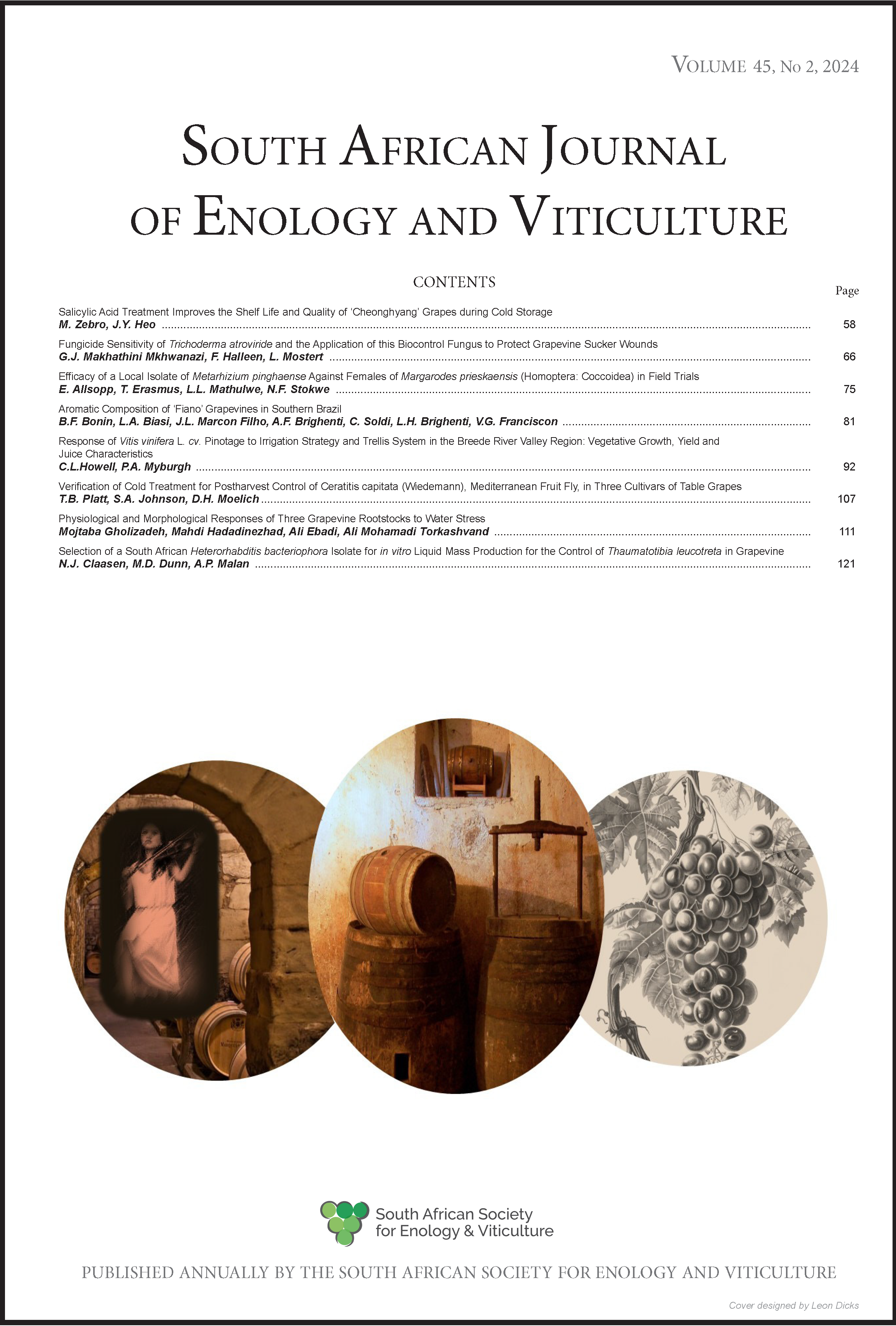Response of Vitis vinifera L. cv. Pinotage to Irrigation Strategy and Trellis System in the Breede River Valley Region: Vegetative Growth, Yield and Juice Characteristics
DOI:
https://doi.org/10.21548/45-2-6531Abstract
Pinotage is a South African bred red wine cultivar and is second only to Shiraz in terms of the country’s wine exports. Since rainfall in the Breede River region is low, vineyards in this region depend on irrigation. The sensitivity of Pinotage/99R to water deficits and the most suitable irrigation strategy during water restrictions were studied in a field trial from 1998/99 until 2000/01. The possibility to produce more grapes with the same volume of irrigation water was also investigated. Irrigation strategies entailed combinations of 50% readily available water (RAW) depletion, 75% RAW depletion and no irrigation between various phenological stages, viz. budbreak, flowering, pea size berries, véraison, 17°B and harvest. Irrigation applied at 50% RAW depletion from budbreak in September until harvest in February was regarded as the control. Each experiment plot was split into a six-strand vertical hedge and a two-tier vertical trellis. The experiment layout was a split plot, randomised block design. Cane mass of grapevines on the two-tier trellis was lower compared to those on the six-strand hedge. Irrigation at 75% RAW depletion level until harvest tended to reduce cane mass compared to more frequent irrigation. Drier soil conditions reduced berry mass, regardless of the trellis system. Sustained water deficits reduced yield, but had little effect on juice acidity and pH. More Pinotage grapes were produced on the two-tier vertical trellis compared to the six-strand hedge with the same amount of irrigation, thereby reducing the blue water footprint and increasing the irrigation water use efficiency substantially.
Downloads
Downloads
Published
Issue
Section
License
A copyright form will be e-mailed to the corresponding author when the manuscript has been accepted for publication.
In principle, the Author agrees to the following when he/she signes the copyright agreement:
I hereby assign to the SOUTH AFRICAN SOCIETY FOR ENOLOGY AND VITICULTURE (SASEV) the copyright of the text, tables, figures, supplementary material, illustrations and other information (the Material) submitted with the manuscript to be published in SOUTH AFRICAN JOURNAL OF ENOLOGY AND VITICULTURE (SAJEV) (the "Article"). The copyright becomes effective from the date the Article has been accepted for publication in SAJEV.
This is an open access journal, and the authors and journal should be properly acknowledged, when works are cited.
Author's may use the publishers version for teaching purposes, in books, theses, dissertations, conferences and conference papers.
A copy of the authors' publishers version may also be hosted on the following websites:
- Non-commercial personal webpage or blog.
- Institutional webpage.
- Authors Institutional Repository.
The following notice should accompany such a posting on the website: This is an electronic version of an article published in SAJEV, Volume XXX, number XXX, pages XXX - XXX, DOI. Authors should also supply a hyperlink to the original paper or indicate where the original paper (www.journals.ac.za/index.php/sajev/) may be found.
Authors publishers version, affiliated with the Stellenbosch University will be automatically deposited in the University's Institutional Repository SUNScholar.
Articles as a whole, may not be re-published with another journal.
The following license applies:
Attribution CC BY-NC-ND 4.0

